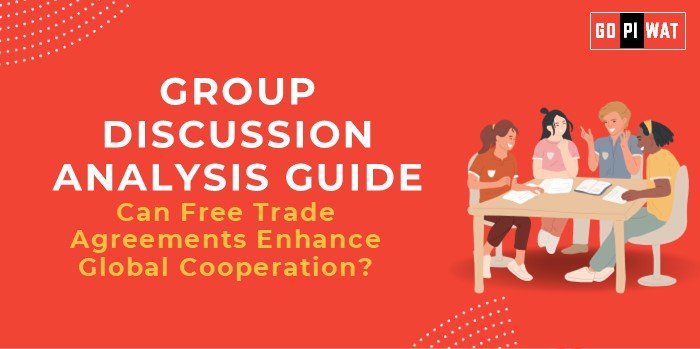📋 Group Discussion (GD) Analysis Guide
🌟 Can Free Trade Agreements Enhance Global Cooperation?
🌐 Introduction to the Topic
Opening Context: “In a rapidly globalizing world, free trade agreements (FTAs) are seen as tools not just for economic integration but also as bridges fostering international cooperation.”
Background: FTAs have historically played a pivotal role in reducing trade barriers, from the 1947 GATT framework to modern agreements like the CPTPP and RCEP. By streamlining trade, they also encourage dialogue on global challenges, such as climate change and labor rights.
📊 Quick Facts and Key Statistics
- 🌍 Global Trade Share of FTAs: FTAs account for over 60% of global trade (WTO, 2024).
- 💼 CPTPP’s Impact: Covers 13% of global GDP, facilitating $13.5 trillion in trade (2023).
- 🇮🇳 India’s FTA Network: Engages in 18 active FTAs, boosting exports by 20% annually in key sectors (Commerce Ministry, 2023).
- 🌏 RCEP’s Trade Volume: Represents 30% of global trade, highlighting its significance as the world’s largest trading bloc (2023).
👥 Stakeholders and Their Roles
- 🇺🇳 Governments: Negotiate and implement agreements while balancing domestic priorities.
- 🏢 Businesses: Leverage reduced barriers for market expansion and innovation.
- 🤝 Labor Unions and NGOs: Advocate for fair trade practices, worker rights, and environmental safeguards.
- 🌐 International Organizations: WTO and UN promote global standards to align FTAs with sustainable development goals.
🏆 Achievements and Challenges
- 🎯 Achievements:
- Economic Integration: NAFTA boosted trilateral trade by 258% from 1994 to 2020 (US Chamber of Commerce).
- Global Standards Alignment: EU FTAs include stringent clauses on labor rights and climate commitments, setting benchmarks for cooperation.
- Conflict Resolution: FTAs foster diplomatic ties by creating interdependence (e.g., US-China Phase One Trade Agreement).
- ⚠️ Challenges:
- Inequality: Smaller economies often struggle to compete with developed nations under FTA rules.
- Compliance Issues: Disputes arise over violations, such as subsidies or intellectual property theft.
- Environmental Concerns: Increased trade sometimes results in higher carbon footprints due to logistics and production.
🌍 Global Comparisons
- 🇪🇺 Success: The EU’s single market demonstrates seamless integration through FTAs.
- 🇺🇸 Failure: US withdrawal from the TPP in 2017 disrupted regional trade dynamics in the Asia-Pacific.
Case Studies:
- ASEAN Free Trade Area (AFTA): Boosted intra-ASEAN trade by 40% in a decade.
- USMCA (Formerly NAFTA): Strengthened North American supply chains, especially in automotive sectors.
📋 Structured Arguments for Discussion
- ✔️ Supporting Stance: “FTAs lower trade barriers and promote shared prosperity, paving the way for trust and collaboration among nations.”
- ❌ Opposing Stance: “While FTAs promote economic integration, they often lead to inequalities and conflicts, hindering genuine global cooperation.”
- ⚖️ Balanced Perspective: “FTAs enhance cooperation when complemented by mechanisms addressing inequities, ensuring mutual benefits.”
🛠️ Effective Discussion Approaches
- 🔍 Opening Approaches:
- Statistical: “Over 60% of global trade flows through FTAs, underscoring their potential for global cooperation.”
- Historical: “From GATT to RCEP, trade agreements have evolved as instruments of both commerce and diplomacy.”
- 💬 Counter-Argument Handling:
- Recognize the exclusionary effects on non-member nations.
- Emphasize the role of inclusive agreements like the WTO frameworks.
📈 Strategic Analysis of Strengths and Weaknesses
- 🟢 Strengths: Streamlined trade processes, diplomatic interdependence.
- 🟡 Weaknesses: Potential for trade imbalances, environmental costs of increased trade.
- 🔵 Opportunities: Expand into emerging markets, use as platforms for addressing global issues (e.g., climate change).
- 🔴 Threats: Over-reliance on trade blocs, risks of geopolitical exploitation.
📚 Connecting with B-School Applications
- 🌏 Real-World Applications:
- Explore supply chain management or cross-border operations research.
- 🤔 Sample Questions:
- “How can FTAs be designed to address environmental concerns?”
- “What role do FTAs play in mitigating global conflicts?”
- 💡 Insights for Students:
- Investigate how FTAs influence regional supply chains.
- Examine their impact on developing nations’ economies.


